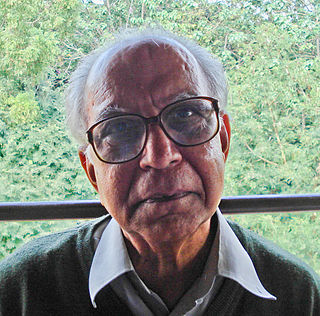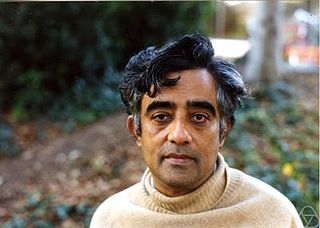
Shiing-Shen Chern was a Chinese American mathematician and poet. He made fundamental contributions to differential geometry and topology. He has been called the "father of modern differential geometry" and is widely regarded as a leader in geometry and one of the greatest mathematicians of the twentieth century, winning numerous awards and recognition including the Wolf Prize and the inaugural Shaw Prize. In memory of Shiing-Shen Chern, the International Mathematical Union established the Chern Medal in 2010 to recognize "an individual whose accomplishments warrant the highest level of recognition for outstanding achievements in the field of mathematics."

Pierre René, Viscount Deligne is a Belgian mathematician. He is best known for work on the Weil conjectures, leading to a complete proof in 1973. He is the winner of the 2013 Abel Prize, 2008 Wolf Prize, 1988 Crafoord Prize, and 1978 Fields Medal.

David Bryant Mumford is an American mathematician known for his work in algebraic geometry and then for research into vision and pattern theory. He won the Fields Medal and was a MacArthur Fellow. In 2010 he was awarded the National Medal of Science. He is currently a University Professor Emeritus in the Division of Applied Mathematics at Brown University.
Vijay Kumar Patodi was an Indian mathematician who made fundamental contributions to differential geometry and topology. He was the first mathematician to apply heat equation methods to the proof of the index theorem for elliptic operators. He was a professor at Tata Institute of Fundamental Research, Mumbai (Bombay).

Tata Institute of Fundamental Research (TIFR) is an Indian Research Institute under the Department of Atomic Energy of the Government of India. It is a public deemed university located at Navy Nagar, Colaba in Mumbai. It also has a campus in Bangalore, International Centre for Theoretical Sciences (ICTS), and an affiliated campus in Serilingampally near Hyderabad. TIFR conducts research primarily in the natural sciences, the biological sciences and theoretical computer science.
Chow Wei-Liang was a Chinese-American mathematician and stamp collector. He was well known for his work in algebraic geometry.

Conjeevaram Srirangachari SeshadriFRS was an Indian mathematician. He was the founder and director-emeritus of the Chennai Mathematical Institute, and is known for his work in algebraic geometry. The Seshadri constant is named after him. He was also known for his collaboration with mathematician M. S. Narasimhan, for their proof of the Narasimhan–Seshadri theorem which proved the necessary conditions for stable vector bundles on a Riemann surface.

Mudumbai Seshachalu NarasimhanFRS was an Indian mathematician. His focus areas included number theory, algebraic geometry, representation theory, and partial differential equations. He was a pioneer in the study of moduli spaces of holomorphic vector bundles on projective varieties. His work is considered the foundation for Kobayashi–Hitchin correspondence that links differential geometry and algebraic geometry of vector bundles over complex manifolds. He was also known for his collaboration with mathematician C. S. Seshadri, for their proof of the Narasimhan–Seshadri theorem which proved the necessary conditions for stable vector bundles on a Riemann surface.
Vikraman Balaji is an Indian mathematician and is currently a professor at Chennai Mathematical Institute. He completed his doctorate in Mathematics under the supervision of C. S. Seshadri. His primary area of research is in algebraic geometry, representation theory and differential geometry. Balaji was awarded the 2006 Shanti Swarup Bhatnagar Award in Mathematical Sciences along with Indranil Biswas "for his outstanding contributions to moduli problems of principal bundles over algebraic varieties, in particular on the Uhlenbeck-Yau compactification of the Moduli Spaces of μ-semistable bundles." He was elected Fellow of the Indian Academy of Sciences in 2007, Fellow of the Indian National Science Academy in 2015 and was awarded the J.C. Bose National Fellowship in 2009.

Raman Parimala is an Indian mathematician known for her contributions to algebra. She is the Arts & Sciences Distinguished Professor of mathematics at Emory University. For many years, she was a professor at Tata Institute of Fundamental Research (TIFR), Mumbai.
Chakravarthi Padmanabhan Ramanujam was an Indian mathematician who worked in the fields of number theory and algebraic geometry. He was elected a fellow of the Indian Academy of Sciences in 1973.

Ramaiyengar Sridharan is a mathematician at Chennai Mathematical Institute, formerly at the Tata Institute of Fundamental Research (TIFR).
Annamalai Ramanathan was an Indian mathematician in the field of algebraic geometry, who introduced the notion of Frobenius splitting of algebraic varieties jointly with Vikram Bhagvandas Mehta in. The notion of Frobenius splitting led to the solution of many classical problems, in particular a proof of the Demazure character formula and results on the equations defining Schubert varieties in general flag manifolds.
Indranil Biswas is an Indian mathematician. He is a professor of mathematics at the Tata Institute of Fundamental Research, Mumbai. He is known for his work in the areas of algebraic geometry, differential geometry, and deformation quantization.
Trivandrum Ramakrishnan "T. R." Ramadas is an Indian mathematician who specializes in algebraic and differential geometry, and mathematical physics. He was awarded the Shanti Swarup Bhatnagar Prize for Science and Technology in 1998, the highest science award in India, in the mathematical sciences category.

Vasudevan Srinivas is an Indian mathematician working in algebraic geometry. He is a Distinguished Professor in the School of Mathematics Tata Institute of Fundamental Research, Mumbai. Srinivas is an elected Fellow of the Third World Academy of Sciences, American Mathematical Society, Indian National Science Academy, and the Indian Academy of Sciences.

Kapil Hari Paranjape is an Indian mathematician specializing in algebraic geometry. He is a Professor of Mathematics at the Indian Institute of Science Education and Research, Mohali.

Klaus Hulek is a German mathematician, known for his work in algebraic geometry and in particular, his work on moduli spaces.
David Arends Gieseker is an American mathematician, specializing in algebraic geometry.










